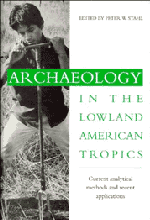Book contents
- Frontmatter
- Contents
- List of figures
- List of tables
- List of contributors
- Introduction
- 1 Archaeological survey and site discovery in the forested neotropics
- 2 The archaeology of community organization in the tropical lowlands: a case study from Puerto Rico
- 3 Archaeological methods for the study of ancient landscapes of the Llanos de Mojos in the Bolivian Amazon
- 4 Searching for environmental stress: climatic and anthropogenic influences on the landscape of Colombia
- 5 “Doing” paleoethnobotany in the tropical lowlands: adaptation and innovation in methodology
- 6 Plant microfossils and their application in the New World tropics
- 7 Differential preservation histories affecting the mammalian zooarchaeological record from the forested neotropical lowlands
- 8 Biological research with archaeologically recovered human remains from Ecuador: methodological issues
- 9 Interpreting dietary maize from bone stable isotopes in the American tropics: the state of the art
- 10 From potsherds to pots: a first step in constructing cultural context from tropical forest archaeology
- 11 Returning to Pueblo Viejo: history and archaeology of the Chachi (Ecuador)
- References
- Index
8 - Biological research with archaeologically recovered human remains from Ecuador: methodological issues
Published online by Cambridge University Press: 23 November 2009
- Frontmatter
- Contents
- List of figures
- List of tables
- List of contributors
- Introduction
- 1 Archaeological survey and site discovery in the forested neotropics
- 2 The archaeology of community organization in the tropical lowlands: a case study from Puerto Rico
- 3 Archaeological methods for the study of ancient landscapes of the Llanos de Mojos in the Bolivian Amazon
- 4 Searching for environmental stress: climatic and anthropogenic influences on the landscape of Colombia
- 5 “Doing” paleoethnobotany in the tropical lowlands: adaptation and innovation in methodology
- 6 Plant microfossils and their application in the New World tropics
- 7 Differential preservation histories affecting the mammalian zooarchaeological record from the forested neotropical lowlands
- 8 Biological research with archaeologically recovered human remains from Ecuador: methodological issues
- 9 Interpreting dietary maize from bone stable isotopes in the American tropics: the state of the art
- 10 From potsherds to pots: a first step in constructing cultural context from tropical forest archaeology
- 11 Returning to Pueblo Viejo: history and archaeology of the Chachi (Ecuador)
- References
- Index
Summary
Although publications with biological information gleaned from archaeologically recovered human remains in Ecuador appeared sporadically during the early twentieth century (for example, Duckworth 1951; Saville 1913), intensive research on these materials did not begin until the early 1970s. Following Munizaga's important work on human remains from sites of Valdivia and Machalilla phases (Munizaga 1965), I initiated excavation and analysis of a variety of well-dated human skeletal remains, initially from precontact sites mostly on the coast, but later including historic sites in the highlands. This work formally began in 1973 with the excavation and analysis of the Late Integration cemetery site at Ayalán (Ubelaker 1981a) in coastal Ecuador and continued in 1974 at the nearby site of San Lorenzo del Mate (Ubelaker 1983a). Since 1974, excavations by many archaeologists have produced important well-dated samples of human remains that offer an unusual opportunity to examine temporal trends and geographic variation in biological information (Ubelaker 1988a).
The extent of the research outlined above is nearly unique in Latin America. Partly to blame for the paucity of such work in other areas is the historical shortage of well-trained physical anthropologists. Although significant samples of human remains have been discovered and excavated over the years, the samples have not been saved or otherwise have lost their provenience and thus much of their scientific value, owing either to a lack of awareness regarding their importance, or a lack of professional interest by physical anthropologists.
- Type
- Chapter
- Information
- Archaeology in the Lowland American TropicsCurrent Analytical Methods and Applications, pp. 181 - 197Publisher: Cambridge University PressPrint publication year: 1995
- 1
- Cited by

